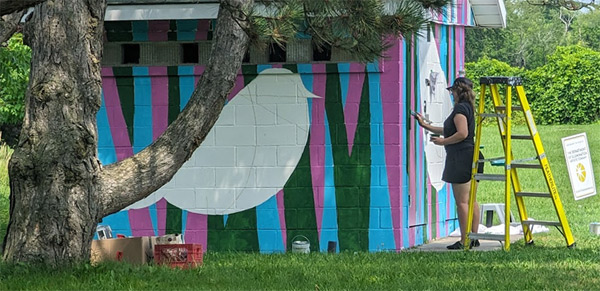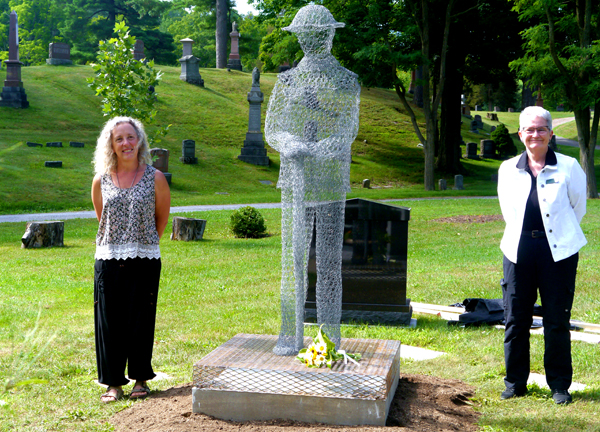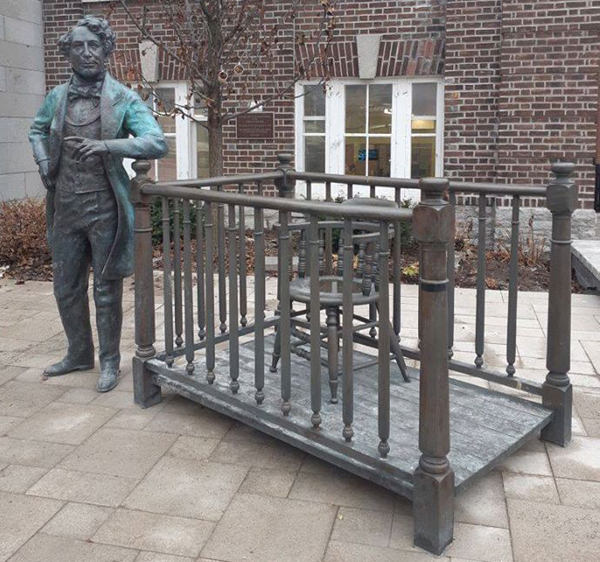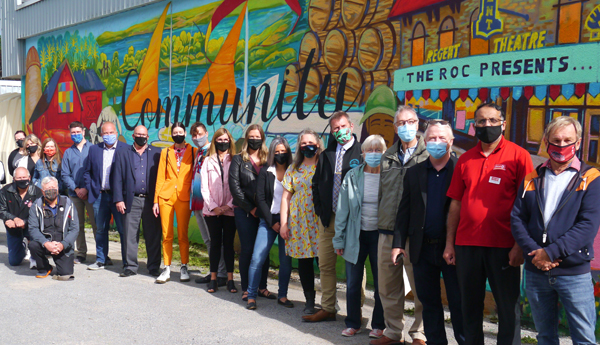County begins to sketch out plan for public art
Administrator | Jul 27, 2023 | Comments 0

The public washrooms at Mill Pond Park (Bloomfield) and Westfall Park (Carrying Place) have been closed for a few days while members of The Department of Illumination created eye-catching designs on the buildings. The County group was awarded the project with funds from the Tourism Relief Fund to raise the visibility of public washrooms. Above, Nella Casson works on the washroom at the Bloomfield Mill Pond Park. – Sue Capon photo
By Sharon Harrison
“We do believe everybody is an artist, everybody who makes art is an artist, and art is so much more than a pretty picture,” said Andrea Dawes, of County Arts.
Art, in its many forms, genres and nuances, she said, has become synonymous with Prince Edward County, a place home to hundreds of artists over many decades, and attracting many more art lovers to the special island community.
Public art exists within the community beyond traditional gallery environments, accessible to all.
Council voted Thursday to continue to develop a public art policy for any public installations or pieces of art, and to direct staff to begin extensive public consultation, led by Prince Edward County Arts Council (County Arts), and to come back to council with a draft public plan.
They also voted to put a temporary 18-month moratorium on permanent public art installations on municipal property until a long-term public art plan and policy is in place.
“Public art guided by expert hands with a long-term vision can create a sense of place and shared identity within a community, and it represents the diversity of heritage practices that are present in every society; it strengthens bonds by constructively prompting reflection and dialogue,” said Chris Palmer, supervisor museums and culture services, in his report.
Councillor John Hirsch raised the point of budgets for public art, noting the report shows the amounts other municipalities have for public art, such as one per cent of their budget goes to public art.
“I’m guessing that our percentage of our budget going to public art right now is having around zero,” said Hirsch.
Palmer said they have discovered several ways that different municipalities fund public art.
“It’s not usually one per cent of an entire budget, it’s often one per cent of their capital budget, and sometimes it’s linked to specific projects,” said Palmer. “There are multiple ways to fund public art. There are limitations to the budget here and what we can do, but everyone is willing to work with what we can do.”
In her deputation to council at Thursday’s committee of the whole meeting, Andrea Dawes, special initiatives manager with the non-profit arts organization, spoke about the proposal for a public art planning process.
She explained what public art is and what it can be for Prince Edward County, and why it is needed, where she indicated that public art can be incorporated in landscaping, streetscaping and wayfinding elements.
Dawes said there are many reasons why a place should adopt public art, as not only can it create new jobs, learning and training opportunities for artists and other contributors in a rural creative economy, but it can engage and embed artists and arts in a creative approach.

Artist Danielle Reddick, and Glenwood Cemetery Chair, Sandy Latchford, flank the new wire soldier sculpture. – Sharon Harrison file photo
“Public art can define, reflect and celebrate our cultural identity and community spirit by interpreting the social, historical, cultural and natural environment, enhance our sense of place, and foster civic pride,” outlined Dawes.
She said something County Arts deeply cares about is breaking down barriers to arts participation by bringing accessible art experiences out into the public realm.
“This is really front of mind for us and we have such a vibrant arts community, but many of the opportunities to interact with art in the County are in private spaces, or open to the public but might require tickets to experience them,” she said. “Public art is really this perfect opportunity to ensure all residents can experience the joy and awe, and all the other benefits of the arts experience.”
Public art already exists around the County, whether on private property accessible to the public or on municipal-owned property, whether it’s brightly-painted picnic tables in public parks, painted murals on buildings, or depicted in a wire statue at Glenwood Cemetery.
Councillor Roy Pennell said he hopes the public art plan includes a very wide spectrum for what is being looked at for art.
“There’s people challenged in different ways on how they may or may not be able to put perfection into a drawing,” said Pennell. “It’s every bit as important to showcase their work as it is anybody that may be many years at doing art.”
Dawes said ideally in a public art program there are opportunities for a range of artists and community members to contribute to public art, from emerging to established artists, but also community members to participate and have a say in the process.
Councillor Bill Roberts spoke to the “huge economic benefit of the arts in Ontario, and potentially here in the County”.
He said there is about $30 billion worth of economic benefit to Ontario, and over 300,000 jobs in arts and arts and culture sector, where Roberts specifically cited three municipal surveys in Ontario.
“One was an 83 per cent support by municipalities for the arts being, not just a secondary thought, but a foundational thought when it came to economic development; and 88 per cent of Ontarians surveyed really appreciated the role of the arts in revitalizing settlement areas, especially in rural areas,” stated Roberts, adding, “It also doubles the extended stay by tourists and visitors to those areas rich with an arts and culture scene.”
“Given the huge impact for municipalities, especially smaller municipalities in terms of economic benefit and community well-being, are we doing enough to really integrate the arts and culture scene here across all the areas of our County municipal decision-making?” he asked.
Addressing the challenge of the County’s quieter shoulder seasons, councillor Sam Branderhorst asked how the program could help in the off-seasons to a year-round thriving community. Dawes said it was a big pillar of what they are working on to seize the shoulder season opportunities.
“We hear again and again that those economic opportunities for artists to create and connect with audiences when the many tourists have gone away,” said Dawes. “More permanent public art installations are here year-round, and it would be a great opportunity for increasing the Prince Edward County experiences, also for residents is really important.”
Branderhorst also said she likes the idea of locations and site selections mentioned in the staff report – including cemeteries, town halls, libraries and areas that are off the beaten path.
Councillor David Harrison and CAO Marcia Wallace reminded that the proposal for a public art plan came as a result of the Sir John A. Macdonald sculpture that resided on Picton’s Main Street, until it was removed.
In April 2022 council directed staff to initiate formal return of the ‘Holding Court’ sculpture to the Macdonald Project of Prince Edward County following two years of outcry and vandalism as some community members attempted to reckon with the national tragedy of the Indian residential school system and Macdonald’s complicated connection. Click here for background stories

The 1,400-pound bronze statue of Canada’s first prime minister – created by renowned Canadian artist Ruth Abernethy – depicts Macdonald as a young lawyer addressing a jury at his first court case in Picton, in 1834.
“Sir John A. is very near and dear to a lot of people; it’s a work of art, so will there be an attempt to work that piece of art into the plan in some way?” asked Harrison, adding, “I don’t want this to be forgotten, and it might be kept on a list of perhaps opportunities to be to incorporated.”
Wallace noted staff have been engaged in dialogue with the Macdonald Project.
“We are currently storing it and protecting it, and we are hopeful that we can get to an agreement and move forward because the intention always was not to keep it in storage, but to give it back to the Macdonald Project so they could find a home for it permanently and I believe they have some ideas of where they want to put it,” said Wallace.
Councillor Phil St-Jean spoke to the economic benefits of the arts in any given community, and the multiplier effect of the arts, where he referenced the staff report: in 2009, $17.75 for every dollar in the city of Toronto spent.
“That’s just an amazing economic multiplier; you are not going to get that from any other industry,” said St-Jean. “In the ‘90s, it was a dollar spent equals $7 for stage productions for the dramatic arts, and I know those numbers have increased greatly.“
“I think this is amazing, it is something that builds on what we already do well; our economic development should concentrate on what we do well moving forward, and for such a very tiny investment.”
Dawes said public consultation is expected to occur this fall to include a variety of activities. County Arts will then provide County staff with a report to include development of recommendations, expected Jan-Aug. 2024, with the final art plan expected with detailed recommendations for action in about a year from now. The process to develop the policy is expected to cost $40,000.
Council is expected to bring this item back for consideration in the final quarter of 2024.
Filed Under: Arts & Culture • Featured Articles • Local News
About the Author:
































